
Triplarina is a genus of seven species of flowering plants in the family Myrtaceae. They are Baeckea-like shrubs with small leaves arranged in opposite pairs and flowers with five sepals, five more or less round petals, and fourteen to eighteen stamens that are shorter than the petals. Species of Triplarina occur in New South Wales and Queensland usually growing in woodland or forest.

Pimelea spinescens, commonly known as plains rice-flower, spiny rice-flower or prickly pimelea, is a species of flowering plant in the family Thymelaeaceae and is endemic to Victoria. It is a spreading undershrub with elliptic leaves arranged in opposite pairs, and heads of white, cream-coloured or yellow flowers surrounded by 4 elliptic, leaf-like involucral bracts.
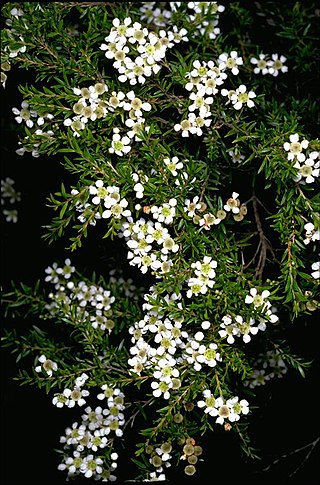
Sannantha similis is a species in the myrtle family, Myrtaceae and is endemic to eastern Australia. It is a shrub with narrowly lance-shaped leaves, and groups of three white flowers arranged in leaf axils.
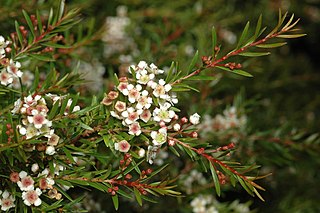
Sannantha bidwillii is a species in the myrtle family, Myrtaceae and is endemic to coastal Queensland in Australia. It is a shrub or tree with elliptic to egg-shaped leaves with the narrower end towards the base, and clusters of 3 white flowers.
Eucalyptus tardecidens is a species of mallee or small tree that is endemic to north Queensland. It has rough, fibrous or flaky bark on the trunk and branches, lance-shaped adult leaves, flower buds in groups of seven, white flowers and shortened oval to cylindrical fruit.
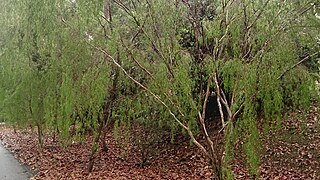
Leptospermum madidum is a species of shrub or small tree that is endemic to north-western Australia. It has weeping branches, smooth bark, pale green linear leaves, small white flowers and thin-walled fruit.
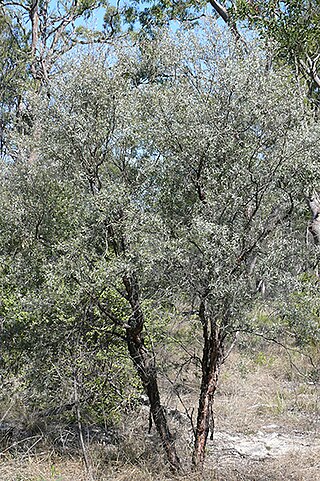
Leptospermum lamellatum is a species of shrub or small tree that is endemic to inland Queensland and has distinctive reddish, layered bark. It has narrow elliptical leaves, white flowers and small fruit that fall from the plant when mature.
Leptospermum pallidum is a species of spreading shrub that is endemic to Queensland. It has thin, firm, rough bark, narrow lance-shaped leaves, white flowers arranged in groups of two or three on side shoots and fruit that remains on the plant until it dies.
Triplarina bancroftii is a species of flowering plant in the myrtle family, Myrtaceae and is endemic to a restricted area of Queensland. It is a shrub with egg-shaped or elliptic leaves, flowers with five sepals and five relatively small white petals and sixteen to eighteen stamens.
Triplarina calophylla is a species of flowering plant in the myrtle family, Myrtaceae and is endemic to a restricted area of north Queensland. It is a shrub with egg-shaped leaves with the narrower end towards the base, flowers with five sepals, five white petals and fourteen or fifteen stamens.

Triplarina imbricata, commonly known as creek triplarina, is a species of flowering plant in the myrtle family, Myrtaceae and is endemic to northern New South Wales. It is a shrub with weeping branches, narrow egg-shaped leaves, and flowers in pairs with five sepals, five relatively small white petals and fourteen to seventeen stamens.
Triplarina nitchaga is a species of flowering plant in the myrtle family, Myrtaceae and is endemic to a restricted area of north Queensland. It is a shrub with lance-shaped leaves with the narrower end towards the base, flowers with five sepals, five white petals and seventeen or eighteen stamens.
Thryptomene remota is a species of flowering plant in the family Myrtaceae and is endemic to the northern part of the Northern Territory. It is an erect shrub with linear to lance-shaped leaves with the narrower end towards the base, and white or cream-coloured flowers with ten stamens.
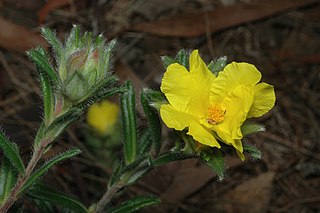
Hibbertia platyphylla is a species of flowering plant in the family Dilleniaceae and is endemic to south-eastern South Australia. It is a shrub with linear stem leaves and yellow flowers arranged singly in leaf axils with ten to fifteen stamens arranged on one side of two carpels.

Pomaderris ligustrina, commonly known as privet pomaderris, is a species of flowering plant in the family Rhamnaceae and is endemic to south-eastern continental Australia. It is a shrub with hairy stems, lance-shaped to narrowly elliptic leaves, and loose clusters of cream-coloured or yellow flowers.
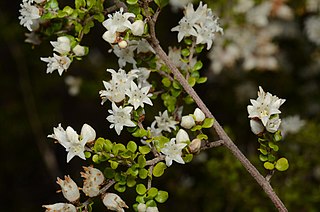
Cryptandra orbicularis is a species of flowering plant in the family Rhamnaceae and is endemic to south-eastern Queensland. It is a shrub with more or less round or kidney-shaped leaves and white to creamy-white, tube-shaped flowers.
Cryptandra pogonoloba is a species of flowering plant in the family Rhamnaceae and is endemic to south-eastern Queensland. It is a shrub with linear to lance-shaped leaves with the narrower end towards the base, and white to creamy-white, tube-shaped flowers.
Sannantha angusta is a species of flowering plant in the family Myrtaceae, and is endemic to eastern Australia. It has scaly to fibrous bark, narrowly lance-shaped to linear leaves and white flowers, and usually grows in forest on rocky hillsides. It was previously known as Babingtonia angusta, and has been cultivated as Baeckea sp. 'Clarence River'.
Sannantha crassa is a species in the myrtle family, Myrtaceae and is endemic to eastern Australia. It is a shrub with elliptic to lance-shaped leaves and groups of 7 to 9 white flowers arranged in leaf axils.
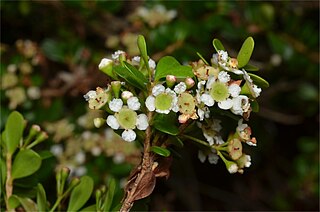
Sannantha tozerensis is a species of flowering plant in the myrtle family, Myrtaceae and is endemic to a small area of Cape York Peninsula in north Queensland. It is a shrub with elliptic to egg-shaped leaves, the narrower end towards the base, and white flowers arranged in groups of three or seven in leaf axils.












